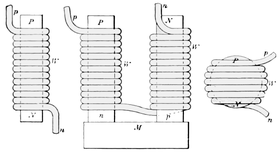made of steel and is hardened it will retain the magnetism, and become what is called a permanent magnet; such a magnet, in fact, as we have considered in all the previous figures. If the bar is made of iron it will not retain the magnetism, but will only be a magnet as long as the electric current  Figs. 6, 7, 8.—Diagrams illustrating the Principles of Electro-Magnets.lows through the coil W. A magnet of the latter type is called an electro-magnet. If the iron is of poor quality—that is, from an electrical standpoint—it will require an appreciable time to lose its magnetism, but if it is soft and high grade, electrically considered, it will lose its magnetism instantly, or nearly so. If we take two bars of soft iron and arrange them side by side, as in Fig. 7, and wind coils around them as indicated each one will become magnetized when the ends p n of the coils are connected with an electric circuit. If the lower ends of the two bars are joined by a piece, as shown at M, we will have a horseshoe electro-magnet. If we take a round disk of iron, as in Fig. 8, and wind a coil around it, it will also become a magnet when an electric current traverses the coil. Thus it will be seen that it makes little difference what the shape of the iron may be, providing it is surrounded by a coil of wire and an electric current is passed through the latter. This being the case, it is evident that either of the processes explained in connection with Figs. 4 and 5 can be made available for the production of a continuous rotation by the aid of electro-magnets. Suppose we make a drum, as shown in Fig. 9, and wind a wire coil around it in the direction indicated, then when a current passes through the wire the drum will be magnetized, with poles at top and bottom. If the electric current passes through the wire from end p to end n the drum will be magnetized positively at the top and negatively at the bottom, and if the direction of the current through the wire is reversed the polarity of the drum will be reversed. If we construct a horseshoe magnet of the shape shown in Fig. 10, and place within the circular opening between its ends the drum of Fig. 9, we will have a device that is capable of developing a continuous rotation, providing we have suitable means for reversing the direction of the electric current through the wire coil; and this machine constitutes an electric motor in its simplest form.
Figs. 6, 7, 8.—Diagrams illustrating the Principles of Electro-Magnets.lows through the coil W. A magnet of the latter type is called an electro-magnet. If the iron is of poor quality—that is, from an electrical standpoint—it will require an appreciable time to lose its magnetism, but if it is soft and high grade, electrically considered, it will lose its magnetism instantly, or nearly so. If we take two bars of soft iron and arrange them side by side, as in Fig. 7, and wind coils around them as indicated each one will become magnetized when the ends p n of the coils are connected with an electric circuit. If the lower ends of the two bars are joined by a piece, as shown at M, we will have a horseshoe electro-magnet. If we take a round disk of iron, as in Fig. 8, and wind a coil around it, it will also become a magnet when an electric current traverses the coil. Thus it will be seen that it makes little difference what the shape of the iron may be, providing it is surrounded by a coil of wire and an electric current is passed through the latter. This being the case, it is evident that either of the processes explained in connection with Figs. 4 and 5 can be made available for the production of a continuous rotation by the aid of electro-magnets. Suppose we make a drum, as shown in Fig. 9, and wind a wire coil around it in the direction indicated, then when a current passes through the wire the drum will be magnetized, with poles at top and bottom. If the electric current passes through the wire from end p to end n the drum will be magnetized positively at the top and negatively at the bottom, and if the direction of the current through the wire is reversed the polarity of the drum will be reversed. If we construct a horseshoe magnet of the shape shown in Fig. 10, and place within the circular opening between its ends the drum of Fig. 9, we will have a device that is capable of developing a continuous rotation, providing we have suitable means for reversing the direction of the electric current through the wire coil; and this machine constitutes an electric motor in its simplest form.
In an electric motor the horseshoe magnet is called the field
